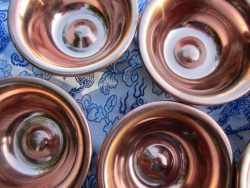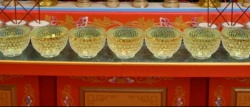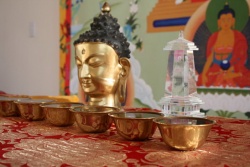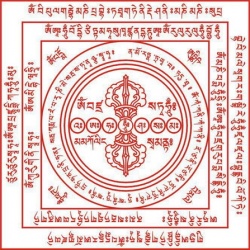Water Offerings
His Holiness Serkong Tsenshab Rinpoche explained to us during the Jorchoe commentary that when you clean the bowls you should use a clean towel. The significance of offering seven water bowls is to create the cause to achieve the seven limbs, or aspects, or qualities of the Vajradhara state, enlightenment. But that does not mean that you cannot offer more, that offering more is some kind of interference!
If you do not have many water bowls it does not matter. The ascetic meditators used their own wooden food bowl. I think it was Je Drukhangpa, a lineage lama of lamrim, the guru of Phurchog Jamgoen Rinpoche, and who is regarded as an embodiment of Maitreya Buddha, who lived an ascetic life practising in a cave. He did not possess texts and the necessary robes (the choegu and dingwa) nor keep many material possessions. When he ate he took his bowl from the altar and ate his food from that. Then he cleaned it well and filled it with water and offered it at the altar. For those living ascetic lives not keeping many possessions has a great purpose. If you are not living a strictly ascetic life you should use your possessions to accumulate as much merit as possible; then you are taking the essence from that which is essenceless. When cleaning the bowls what you should think is the same as when cleaning the room. I do not remember word for word what Rinpoche explained, however when one cleans the room one should think that the broom represents method and wisdom, the whole path to enlightenment. So think the same in regard to the towel, and you can think that you are purifying the two obscurations of yourself as well as all sentient beings. If you have incense, light it and hold the bowls over it as a purification. Then stack the bowls.
Before putting the bowls on the altar you should put some water in them. There is a reason for this. You may have read Milarepa’s life story. When Milarepa made an offering to Marpa of, I think, a big copper pot, he offered it empty. It is said that he had to live on only nettles and bear great hardships in regard to food and the necessities of life because of the dependent arising due to that inauspicious offering. Marpa, knowing that it was a little inauspicious used a skilful method and asked Mila to fill the pot with butter and wax and make a light offering. That auspicious offering was the cause for Milarepa to be able to realize shunyata and generate the clear light and illusory body in that life. You can understand the purpose from stories like that; otherwise it looks like nothing more than just a rule saying one has to do this and this. So, you should not put empty containers in front of the altar; similarly, when you make offerings to the virtuous teachers put something in the container.
Fill one bowl with water, then pour most of it from that one into the next bowl, keeping a little in the first. Then again from the second one pour most into the third, keeping a little in the second. After you have put some water in the last bowl recite OM AH HUNG three times to bless the water, the same as with the inner offering. If you are a gelong and offering incense you should immediately remember: I’m doing this for Dharma practice; I’m doing it for other sentient beings. The reason for remembering at the time is to get permission. Saying the relevant prayers in the morning is a tradition from Panchen Losang Choegyen; it is a method for somebody who forgets to seek permission at the actual time of the action to receive fewer vices. In this way one gets permission in the morning to do actions during the day such as sing or touch and keep things in one’s house, to keep more food than is needed that day, to make fire and cook, to eat foods which have been gathered. I am not sure that if one has done the prayers in the morning but at the time of actually doing these things it is alright to have worldly concern and not think it is for the sake of other sentient beings, for dharma reasons. I think that to remember at the actual time is the main thing: that is why it is called du ten – remembering at the time. So when a monk lights incense he should remember the gelong vow immediately, and think that it is for the sake of sentient beings, for Dharma practice. Then one will not degenerate the vows or receive vices.
Each time you light incense or a butter-lamp or some light, just before you offer it recite OM AH HUNG, then offer it. There are various interferers, three hundred and sixty or something different dooens, who take the essence. Maybe that is sort-of their enjoyments. If you offer without blessing you do receive the merit, but there is some interference in regard to the offering – it affects the mind, making it kind-of unclear or unstable. In order for these things to not happen recite the mantra OM AH HUNG and bless the offerings.
You should cover your mouth in order to not pollute the offerings with a smelly breath. His Holiness Serkong Rinpoche said the scarf should be white. We see the servants of the high lamas such as His Holiness the Dalai Lama cover their mouths with a white cloth or scarf when serving tea and so on. Also the offerings are carried high.
So when you make offerings in front of an altar you should not think, I am just putting water in front of clay statues or pictures. You should act as if you are in front of a king or high lama and serving him. Due to our karmic obscurations we do not see the images as real, but Chakrasamvara is there, Tara is there, all the buddhas are there. The whole merit field is there, but due to karmic obscurations we do not see them. The karma that we have at the moment is to see merely pictures and statues of the deities. This is explained in the lamrim teachings, as well as by Phabongkha Dechen Nyingpo, I think, and His Holiness Trijang Rinpoche, His Holiness Ling Rinpoche, as well as Serkong Rinpoche.
The bowls should be placed so that they are not touching nor too far apart. Due to inauspiciousness or dependent arising of them being too far apart you will be distant from the virtuous teacher in the future. So do not place them far apart, but also not touching. I think due to the dependent arising from placing them too close you will have a dull mind, without sharp intelligence. You should place them the distance of one rice grain apart. In regard to pouring the water His Holiness Song Rinpoche used to advise to first pour slowly, then faster, and then again slowly. Doing it that way does not make a loud splashing noise. If you put too much water into the bowl and it overflows you will have intelligence, but it will not be stable. You will easily forget or will not have a clear mind, things will get mixed up. You will not remember words or the meanings of things, or the meanings will get mixed up. Also it may affect your moral conduct causing it to degenerate. Some bowls made in Nepal have lines to indicate how much water to offer in the bowl. About one grain-length of space should be left at the top, rather than filling it completely. That also makes it easier to avoid making a mess when you remove the bowls from the altar.
You can recite the mantra OM AH HUNG again while you are offering, or the long mantra for blessing and multiplying the offerings:
OM NAMO BHAGAVATE BENDZA SARWA PRAMADANAYE TATHAGATAYA ARHATE SAMYAKSAM BUDDHAYA
The benefit of reciting this is that not only are the offerings blessed, but clouds of offerings are received in front of each of the beings in the merit field. You can think in this way even at the very beginning of the offering. Whether you have Chakrasamvara or Guru Shakyamuni or Vajrasattva, or whatever, as your field of merit, think that what they see is nectar. To you it is water, but what the buddhas see is nectar. For a preta it is blood and pus, for us it is water; even the devas see it as nectar, so without question it is nectar for the buddhas who have completed the merit of transcendental wisdom and method. Think, I’m offering them the nectar which appears to them. While you are offering think that whatever pictures or statues of guru-deities you have are the embodiment of all Buddhas of the ten directions, the embodiment of the Guru, of all three refuges, and that you are offering to all of them and that it generate infinite bliss in their minds. As explained in the section on making offerings, offer the water bowls to every single holy object and actual living Buddha and Bodhisattva in the ten directions. You can concentrate on this while you are offering. As you are filling the bowls, with your mouth recite the mantra for blessing, with your mind offer to all of them. After you have finished a set of offerings you can do the same meditation of offering over again.
His Holiness Serkong Tsenshab Rinpoche used to advise that at the end you should dedicate the merit in this way: May this merit from making offerings (and all the merit accumulated by me and all other sentient beings) not be experienced by me but rather only by other sentient beings. Rinpoche’s specific advice is to pray that the merit and whatever resultant happiness will come from that be received and experienced by other sentient beings, and that oneself not experience it. You should think like that. Each time dedicate for the generation of bodhicitta with the prayer jang chub sem chog rinpoche… even if you do other dedications; then it becomes a practice of the five powers of thought-training. Accumulating merit in order to generate bodhicitta is the practice of the power of the white seed. You should dedicate the merit to achieve enlightenment quickly and quicker for the sake of all sentient beings in whatever way you know.
When you do a hundred thousand water bowl offerings offer them inside if it is easier, if not then at the beach! Fill the whole beach with bowls! Then maybe the next day you will be taken to an institution or a psychologist! If it is difficult to bring water repeatedly from some distance then go to a place having water such as a river and set up the bowls on a big board. That may be easier. When it rains it may be even easier as you will not have to pour water! You just put the bowls out! When you clean the bowls each day you should clean them well, not just patting them with the towel. You must dry them well, not leaving them damp. Not just like giving them a sort-of blessing! If there are any stains you should try to clean them with sand or other cleaning materials.
You can begin with the refuge and Bodhicitta prayer sangye choe dang… Then on the basis of the Lama Choepa or the elaborate Gaden Lha Gyama, make the offerings by setting out the fifty or one hundred or more bowls at the offering section of the seven limb practice. Then there is a dedication at the end. Then you pour out the water and rinse the bowls with water. Then you begin again with sangye choe dang… and then do the offering section of the seven limb practice and again do the meditation of offering. Then again the dedication, and then pour out the water. And perform the offering again. “Beautifully performed, without being crooked” could mean performing the external offering in a symmetrical way; but the main thing is to do it without having a crooked mind, which means make the offering without being stained by worldly concern.




